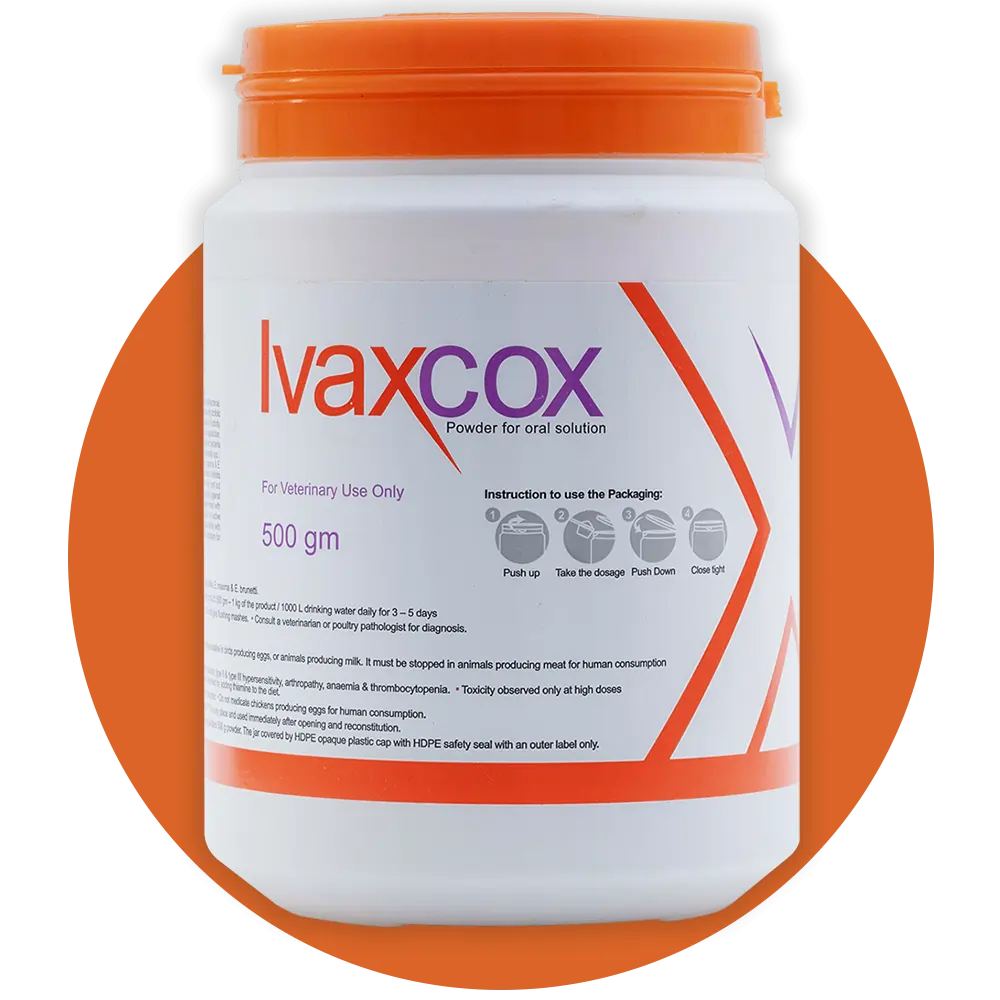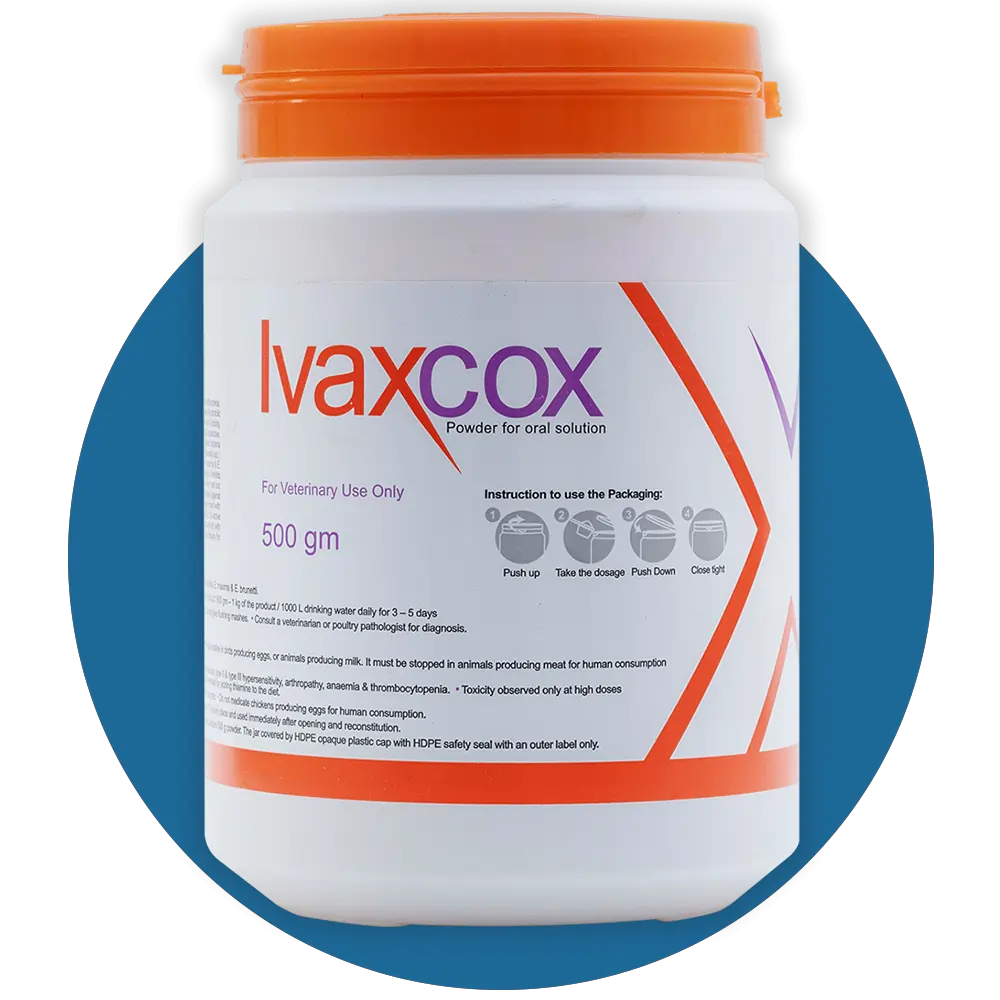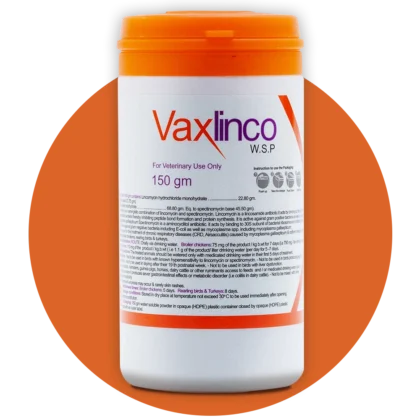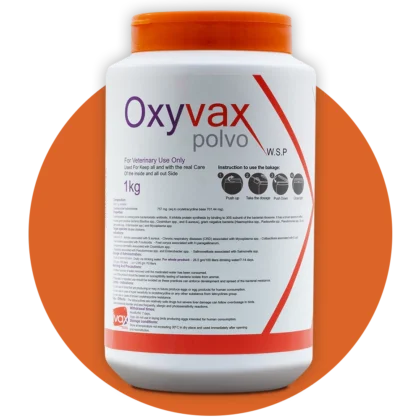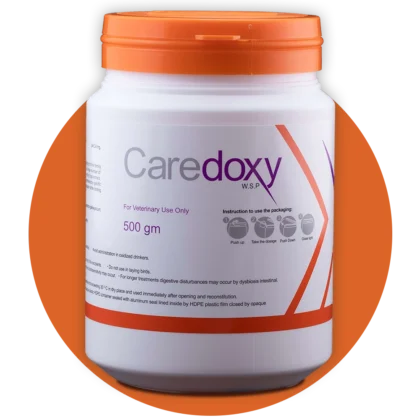Each 100 gm contains:
Sulfaquinoxaline sodium: 20 gm
Amprolium HCl: 20 gm
Diaveridine HCl: 2.1 gm
Vit. K3: 2 gm
Ivaxcox
- composition
- properties
- target species
- indications
- side effects
- withdrawal time
- storage condition
- package
- dosage
- warning
- Do not change litter unless absolutely necessary.
- Do not give flushing mashes.
- Consult a veterinarian or poultry pathologist for diagnosis.
- Medicated chickens must actually consume enough medicated water.
- contra indications
- Description
- Do not change litter unless absolutely necessary.
- Do not give flushing mashes.
- Consult a veterinarian or poultry pathologist for diagnosis.
- Medicated chickens must actually consume enough medicated water.
- Do not administer in birds with sensitivity to sulfonamides.
- Do not use sulphaquinoxaline in birds producing eggs, or animals producing milk. It must be
- Adverse effects associated with sulfonamides include, allergic reactions, type II & type III
- Toxicity observed only at high doses. CNS signs are caused by thiamine deficiency, which
- Withdraw use of product 10 days before slaughter.
- Do not medicate chickens producing eggs for human consumption.
product is an anticoccidial compound, contains Sulphaquinoxaline, Amprolium, Diaveridine & Vitamin K3.
Sulfaquinoxaline is a sulfonamide antibacterial. It competes with para-aminobenzoic acid (PABA) for enzyme that synthesizes dihydrofolic acid in bacteria. Bacteriostatic. Like other sulfonamides, it has a broad spectrum of activity, including gram-positive bacteria (Staphylococcus aureus, Streptococcus agalactiae, Streptococcus dysgalactiae & Corynebacterium pyogenes), gram-negative bacteria (E. coli, Salmonella spp., Klebsiella spp., Bordetella bronchoseptica & Pasteurella spp.) & some protozoa (Eimeria spp. as E. tenella, E. necatrix, E. acervulina, E. maxima & E. brunetti). .
Amprolium acts upon the early first generation schizont & merozoites. It inhibits the uptake of thiamine by coccidia. It is also a thiamine antagonist of the host but the parasite is some 50 times more sensitive to this effect. It exhibits high activity against E. tenella & E. acervulina,& to increase the spectrum of activity, it was usually mixed with sulphaquinoxaline.
Diaveridine isa pyrimidine derivative folic acid antagonist. It is active against the protozoan enzyme dihydrofolate reductase. It has synergistic activity with sulfonamides & often is used in mixtures with these compounds.
Vit. K3 is necessary for the synthesis of blood clotting factors in the liver.
For the treatment of:
Intestinal & caecal coccidiosis disease caused by E. tenella, E. necatrix, E. acervulina,
maxima & E. brunetti.
Adverse effects associated with sulfonamides include, allergic reactions, type II & type III hypersensitivity, arthropathy, anaemia & thrombocytopenia.
Toxicity observed only at high doses. CNS signs are caused by thiamine deficiency, which may be reversed by adding thiamine to the diet.
Withdraw use of product 10 days before slaughter.
Do not medicate chickens producing eggs for human consumption.
Store at a temperature not exceeding 30°C in a dry place and used immediately after opening and reconstitution .
HDPE opaque plastic jar contains LDPE plastic bag contains 500 g powder and tightened with LDPE opaque plastic seal strip, The jar covered by HDPE opaque plastic cap with HDPE safety seal with an outer label only.
Taken orally via drinking water.
For whole product:
500 gm – 1 kg of the product / 1000 L drinking water daily for 3 – 5 days
Do not administer in birds with sensitivity to sulfonamides.
Do not use sulphaquinoxaline in birds producing eggs, or animals producing milk.
It must be stopped in animals producing meat for human consumption 10 days before slaughter.
Composition:
Each 100 gm contains:
Sulfaquinoxaline sodium 20 gm
Amprolium HCl 20 gm
Diaveridine HCl 2.1 gm
Vit. K3 2 gm
Properties:
product is an anticoccidial compound, contains Sulphaquinoxaline, Amprolium, Diaveridine & Vitamin K3. Sulfaquinoxaline is a sulfonamide antibacterial. It competes with para-aminobenzoic acid (PABA) for enzyme that synthesizes dihydrofolic acid in bacteria. Bacteriostatic. Like other sulfonamides, it has a broad spectrum of activity, including gram-positive bacteria (Staphylococcus aureus, Streptococcus agalactiae, Streptococcus dysgalactiae & Corynebacterium pyogenes), gram-negative bacteria (E. coli, Salmonella spp., Klebsiella spp., Bordetella bronchoseptica & Pasteurella spp.) & some protozoa (Eimeria spp. as E. tenella, E. necatrix, E. acervulina, E. maxima & E. brunetti). . Amprolium acts upon the early first generation schizont & merozoites. It inhibits the uptake of thiamine by coccidia. It is also a thiamine antagonist of the host but the parasite is some 50 times more sensitive to this effect. It exhibits high activity against E. tenella & E. acervulina,& to increase the spectrum of activity, it was usually mixed with sulphaquinoxaline. Diaveridine isa pyrimidine derivative folic acid antagonist. It is active against the protozoan enzyme dihydrofolate reductase. It has synergistic activity with sulfonamides & often is used in mixtures with these compounds. Vit. K3 is necessary for the synthesis of blood clotting factors in the liver.
Target species: Broiler chickens – Replacement chickens.
Indications:
For the treatment of:
Intestinal & caecal coccidiosis disease caused by E. tenella, E. necatrix, E. acervulina,
maxima & E. brunetti.
Dosage & Route of administration: Taken orally via drinking water.
For whole product:
500 gm – 1 kg of the product / 1000 L drinking water daily for 3 – 5 days
Warning & precaution:
Contra-indications:
stopped in animals producing meat for human consumption 10 days before slaughter.
Side effects:
hypersensitivity, arthropathy, anaemia & thrombocytopenia.
may be reversed by adding thiamine to the diet.
Withdrawal time:
Storage condition:
Store at a temperature not exceeding 30°C in a dry place and used immediately after opening and reconstitution .
Package:
HDPE opaque plastic jar contains LDPE plastic bag contains 500 g powder and tightened with LDPE opaque plastic seal strip, The jar covered by HDPE opaque plastic cap with HDPE safety seal with an outer label only.

